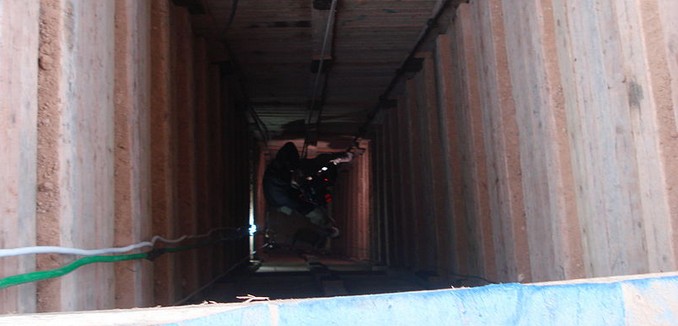The Palestinian terrorist group Hamas announced that one of its operatives was electrocuted to death while working on a tunnel in the Gaza Strip on Saturday, Israel Army Radio reported. The news comes as residents of Gaza who seek to rebuild their homes face difficulty in securing the necessary electricity and other resources, which are routinely appropriated by Hamas.
Israel was forced to increase the amount of electricity it sends to Gaza in June after repeated shutdowns at Gaza’s only power plant due to a payment dispute between Hamas and Fatah. Because of this infighting, Gaza residents usually only have six to eight hours of electricity per day. The lack of power has also caused failures at Gaza’s new $100 million sewage treatment facility, which was built with financing from the World Bank.
Hamas’ mismanagement and misappropriation of resources meant for civilian construction have increasingly come into the spotlight in recent weeks. Earlier this month, the Shin Bet charged Mohammad el-Halabi, the Gaza director for the international charity World Vision, of funneling millions of dollars to Hamas. El-Halabi admitted under interrogation to diverting World Vision funds to Hamas for the purpose of purchasing weapons and building terror tunnels and military bases.
The Shin Bet announced last week that it had arrested a Palestinian employee of the UN Development Program who gave Hamas access to materials used to build, among other things, a port. That same day, the charity Save the Children announced that it was investigating one of its employees for aiding Hamas.
This naval dock was built by #Hamas using UN resources designated for humanitarian aid. pic.twitter.com/3pQOsjReGV
— IDF (@IDFSpokesperson) August 9, 2016
There have been multiple reports of injuries due to tunnel construction in Gaza this month, with eight Palestinians said to be wounded after a tunnel caved in last week.
Brig. Gen. (res.) Yossi Kuperwasser, formerly the head of the research division of Israeli military intelligence and later the director general of the Ministry of Strategic Affairs, told reporters in May that the discovery of the tunnels was a sign that Hamas was preparing for another war against Israel. He added that the tunnel digging means that “they definitely invest a lot in making the necessary preparations so that in the next round, when they decide to start it, they will be able to inflict the heaviest damage on Israel, including through those tunnels.”
Commenting on the efforts Hamas was putting into its terror tunnels at the expense of Gazans, long time Palestinian affairs correspondent Khaled Abu Toameh observed, “the last thing Hamas cares about is the welfare of the Palestinians in the Gaza Strip,”
Haaretz’s defense correspondent Amos Harel wrote in January that “Hamas is investing great efforts and huge sums in the tunnel project. It is reasonable to assume that the number of tunnels crossing under the border is close to that on the eve of Protective Edge,” or the 2014 Gaza war.
In Your Complete Guide to Hamas’ Network of Terror Tunnels, which was published in the April 2016 issue of The Tower Magazine, Dan Feferman observed that the people of Gaza pay the price for Hamas’ efforts to rebuild its tunnels.
There is a tragic side to Hamas’ tunnel strategy. Roughly 9,000 homes were destroyed during Protective Edge, and very few have been rebuilt. This is not Israel’s fault, as building supplies flow regularly into Gaza. But according to declassified intelligence reports, these supplies are routinely stolen by Hamas in order to serve the group’s terrorist purposes. Hamas smuggles in cement, diverts from construction and humanitarian donations, and even raids civilian construction sites in order to rebuild its tunnels. Estimates are that one tunnel can cost a million dollars to build and uses around 50,000 tons of concrete. Close to a million tons of concrete were poured into the terror tunnels before 2014.
The tunnels, in this sense, are a zero-sum game. If the same materials were put into reconstruction, the Gazan people would be better off and, lacking this crucial asymmetric warfare capability, Hamas would be less tempted to attack Israel. On the other hand, with the same limited materials going to terror tunnels, the people of Gaza continue to live in ruins while Hamas rebuilds its war machine.
While Hamas appears to be deterred in the short term, it continues to believe that the tunnels are its only strategic weapon. While it may not be interested in another war, the tunnels continue to be dug for a reason. Once used, however, they lose their effectiveness, as the IDF knows their locations and can thus destroy them. Hamas is well aware of this dilemma. The tunnels essentially leave Israel and Hamas in an arms race—with Israel racing to develop a technological solution before Hamas decides to launch another round of fighting.
[Photo: Al Jazeera English / WikiCommons ]




